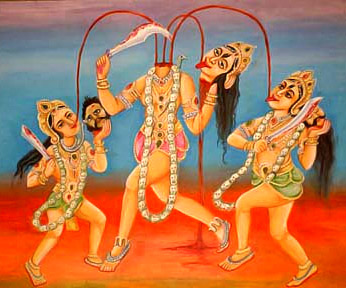 Chhinnamastika is often named as the fifth Ten Mahavidyas in the group, with hymns identifying her as a fierce aspect of the Goddess. An eighteenth century painting from Rajasthan depicts Chhinnamastika as black as described in Pranotasani Tantra legend. She is seated on the copulating couple.
Chhinnamastika is often named as the fifth Ten Mahavidyas in the group, with hymns identifying her as a fierce aspect of the Goddess. An eighteenth century painting from Rajasthan depicts Chhinnamastika as black as described in Pranotasani Tantra legend. She is seated on the copulating couple.
Legends of Chhinnamastika
Pranotasani Tantra narrates two tales about the origin of Chhinnamasta`s birth. The story narrates that once Parvati along with her attendants Jaya-Vijaya went to take bath in the Mandakini River. While bathing the goddess became sexually exited and thus turned black. At that moment her two attendants begged the mother for food as they were very hungry. Parvati tried to calm them down promising to give them food once they returned home but the attendants kept on pleading. The goddess then finally beheaded herself by her nails and gave her blood to satiate their hunger.
The other story from Pranotasani Tantra, attributed to Svatantra-tantra, is narrated by Lord Shiva himself. In the Krita Yuga Mahamaya was engaged in Mahavrata i.e. coitus with Lord Shiva. At that moment the goddess became fierce at his ejaculation and from her body emerged two Shaktis, Dakini and Varnini who later became her attendants. One day the goddess along with her attendants went to the bank of Puspabhadra River. At noon her attendants asked for food. Hence the goddess severed her head and the bloodstream that oozed out satisfied Dakini and Varnini. The goddess also drank her own blood. Later Candanayika replaced her head back on her body. The incident took place on the day of Viraratri; hence, Chinnamasta is said to be born on that day.
There are other references where the appearance of Chinnamasta is apparent. According to an oral legend the goddess Prachanda-Chandika appeared to help the gods in the god-demon war. Goddess Mahashakti was summoned by the gods to aid them. After slaying the demons, the enraged goddess severed her own head too and drank her own blood. The name Prachanda-Chandika is also used for Chhinnamastika in her hundred-name hymn in Shakta-pramoda. Another oral legend relates her to the Samudra manthan (Churning of Ocean) episode, where the gods and demons churned the milk ocean to acquire the amrita (the elixir of immortality). Chhinnamasta drank the demons` share of the elixir and then beheaded herself to prevent them from acquiring it. Chhinnamasta is popular in Tantric and Tibetan Buddhism, where she is called Chinnamunda, the severed-head form of goddess Vajrayogini or Vajravarahi.




















